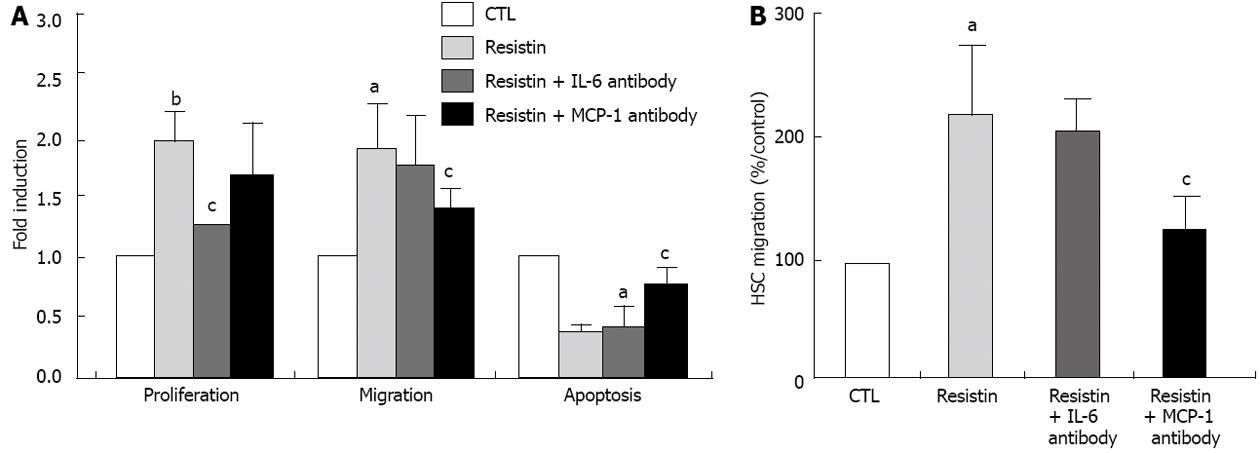Copyright
©2013 Baishideng Publishing Group Co.
World J Gastroenterol. Jul 28, 2013; 19(28): 4475-4485
Published online Jul 28, 2013. doi: 10.3748/wjg.v19.i28.4475
Published online Jul 28, 2013. doi: 10.3748/wjg.v19.i28.4475
Figure 3 Resistin promotes hepatic stellate cells proliferation and migration but decreases hepatic stellate cells apoptosis in an interleukin 6 and monocyte chemotactic protein-1 dependent mechanism.
BrdU, enzyme-linked immunosorbent assay, Wound Scratch Assay (or Boyden chamber) and annexin V/IP flow cytometry were performed to determine hepatic stellate cells (HSCs) proliferation, migration and apoptosis, respectively. For the interleukin 6 (IL-6) and monocyte chemotactic protein-1 (MCP-1) inhibition experiments, IL-6 and MCP-1 neutralizing antibodies (5 μg/mL and 10 μg/mL, respectively) were added to the culture 1 h before resistin (500 ng/mL) administration. Resistin (500 ng/mL) was added to rat HSCs at day 4 for 24 h. Absorbance was measured and apoptosis assessed. For the migration assay, rat HSCs at day 6 were used. After a scratch wound was made, resistin (500 ng/mL) was added and the cells were cultured for 6 h and photographed. For the Boyden chamber assay, the detailed procedure is described in the Materials and Methods section. A: Resistin promoted HSC proliferation and migration, but inhibited HSC apoptosis, while IL-6 and MCP-1 antibodies reversed the resistin-induced HSC phenotype; B: The Boyden chamber assay confirmed that resistin enhanced HSC migration and MCP-1 neutralization reversed this effect. Results are mean ± SD of at least three independent experiments performed in triplicate. aP < 0.05 and bP < 0.01 vs control (untreated); cP < 0.05 vs resistin treatment alone.
- Citation: Dong ZX, Su L, Brymora J, Bird C, Xie Q, George J, Wang JH. Resistin mediates the hepatic stellate cell phenotype. World J Gastroenterol 2013; 19(28): 4475-4485
- URL: https://www.wjgnet.com/1007-9327/full/v19/i28/4475.htm
- DOI: https://dx.doi.org/10.3748/wjg.v19.i28.4475









